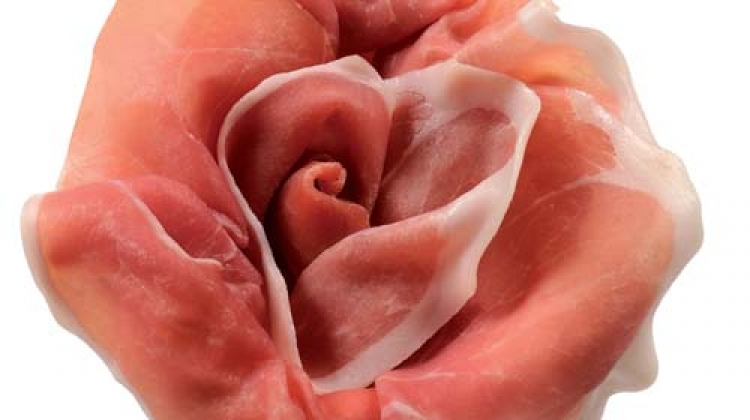Languages
Parma Ham

“Smiling, she brought me buttered bread, ham –pink and white– still warm on a coloured plate, fragrant ...” (Arthur Rimbaud)
The practice of preserving meat with salt is firmly rooted in Italian culture. It is really the marriage of two traditions, the use of sea salt from Mediterranean cultures and the Celtic taste for pork. The remains of so-called “turbary” pigs have been found alongside fragments of oak wood and acorns in the bronze-age Terramare villages near Parma, evidence that some form of pig farming was practised in the Emilia region during this period.
The Etruscans of the 5th century BC are known to have used salt to preserve pork and, as testified by the writings of Varro and Columella (De salatura suillae carnis), the Romans perpetuated the practice in the centuries that followed.
The primary reason for preserving meat was to provide rations for the armed forces. Indeed, Christopher Columbus requested supplies of this indispensable foodstuff for his second voyage of discovery to the Americas.
Eating ‘raw’ cured ham, however, is a relatively recent phenomenon, a 19th-century development. Previously, the meat would be cooked before eating, allowing some of the salt to be removed and the meat to be moistened – both processes necessitated by the generous quantities of salt used in preserving meats in relatively unhygienic conditions. The celebrated Roman gourmet Apicius advised that the meat be cooked simply in water with dried figs, pieces of bread and reduced grape must or spiced wine (ex aqua cum caricis cocta simpliciter, ut solet, inlata cum budelli, coroeno vel condito). It was the advent of modern refrigeration that gave birth to the ageing process we know today.
It is an entirely natural product, free from preservatives and other additives, and is easy to digest. It is, therefore, suitable for children, the elderly and anyone who exercises regularly. It contains:
BRANCHED-CHAIN AMINO ACIDS, which contribute to improved mental function, reaction times, mood and the health of the liver and immune system. They are also essential components in the synthesis of muscle proteins;
UNSATURATED FATTY ACIDS, so-called “good fats”, such as OLEIC ACID;
GROUP B VITAMINS, which are important for the normal functioning of the nervous system, for gastrointestinal muscle tone, and for the conversion of carbohydrates into glucose;
IRON, VITAMIN E AND SELENIUM.
There are around 100 facilities entitled to produce this heavenly delicacy. A number of these have developed their own take on the classic prosciutto. Galloni, for instance, have created a ‘barrel-aged’ ham. After a protracted period of air-drying, the ageing process culminates with four months in oak barriques that were previously used for ageing fine red Italian wine. Another variation is the Rosa dell'Angelo, prosciutto produced with the meat of the rare Nero di Parma breed.
Of the innumerable illustrious devotees of the “King of Parma” we might single out Hannibal, who is said to have feasted on ham upon his arrival in Parma following the Battle of the Trebbia (217 BC), and Rossini, most celebrated as a composer but also a famous gourmet, who made frequent use of prosciutto from Parma in his delightful recipes. Verdi, we can be sure, was also served the local prosciutto at the salon of his great friend, the Countess Clara Maffei. Indeed, the letters of his fellow diners confirm as much.
Gerard Depardieu chose Galloni to supply prosciutto to his restaurants.
Prosciutto di Parma is also an ambassador for Italy.
The “King of Hams” is part of a three-year project entitled “Legends from Europe”, which is co-funded by the EU and aims to promote four prominent Italian PDO products in the United States through trade shows, annual seminars, retailer-centred events, and a collaboration with the Culinary Institute of America, which will provide training to the “Legends from Europe” project’s ambassador-chefs.
Tacca Alda, Se si ascolta la storia. La lunga strada del Prosciutto di Parma, 2003;
Tacca Alda, Perna et Parma: una biografia del prosciutto, 1990;
Consorzio del Prosciutto di Parma, Prosciutto di Parma: un viaggio nel gusto, 2007 + DVD;
Brugnoli Alessio, Farsi prosciutto: percorso in immagini attraverso la lavorazione del Crudo di Parma, 2007;
Parma : l'arte del prosciutto, 2007;
Romanelli Leonardo, Prosciutto : storia, varietà e assaggi di un alimento da buongustai, 1999;
Dall’Olio Enrico, Prosciutto di Parma, 1989.
Prosciutto di Parma: un mito con tante storie da raccontare, 2008.
Tragedy of a Ridiculous Man, 1981 Bernardo Bertolucci.
The Silence of the Hams, 1994 Ezio Greggio.
Ask Me if I’m Happy (Chiedimi se sono felice), 2000 by comic trio Aldo, Giovanni and Giacomo, and Massimo Vernier.
Jamon Jamon, 1992 Bigas Luna.
Every phase of production is regulated and monitored to ensure it complies with the precise requirements set out by the Consorzio del Prosciutto di Parma, and by the Istituto Parma Qualità, which were founded in 1963 to guarantee quality, and adherence to the regulations throughout the production process. It is they who confer the emblem of the ducal crown that marks a true Prosciutto di Parma.
It all starts with the right pig. The guidelines require that the pigs must be sourced exclusively from the Emilia Romagna, Lombardy, Veneto, Piedmont, Tuscany, Molise, Umbria, Lazio, Marche and Abruzzo regions. The pigs should not weigh less than 145 kg, nor be younger than nine months and only the Large White, Landrace and Duroc breeds can be used.
After butchering, legs deemed fit to be turned into Parma Ham are identified, branded with the “P.P.” symbol and the butcher’s own identifying code. A ham may be aged for 24 months or more before it goes on sale.

Geographical Designation
Prosciutto di Parma is produced in a clearly designated area close to the city of Parma. This typically hilly territory, which can reach a maximum altitude of 900 m, starts 5 km to the south of the Via Emilia, and is bordered to the east by the River Enza and to the west by the River Stirone. All production facilities must be located within these boundaries.
Crudo di Parma –raw Parma Ham– has a number of qualities that have seen it awarded PDO status (Protected Designation of Origin) and have brought it international success, with exports reaching all corners of the globe: it has an unmistakeable, sweet flavour, is easy to digest, offers a range of nutritional benefits, and comes with a certified guarantee of its provenance and the methods of production used.